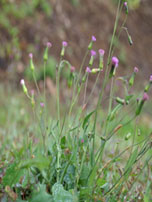Sasasruti

Botanical Name : Emilia sonchifolia (L.) DC. ex Wight
Family : Asteraceae
Introduction :
Emilia sonchifolia, also known as lilac tasselflower or cupid’s shaving brush, is tropical flowering species of tasselflower in the sunflower family. It is widespread in tropical regions around the world, apparently native to Asia (China, India, Southeast Asia, etc.) and naturalized in Africa, Australia, the Americas, and various oceanic islands
Names in different Indian languages :
English : Red tassel flower
Hindi : hirankuri
Kannada : ili kivi gida
Malayalam : muyalchevi
Sanskrit : sasasruti, Akhukarni
Tamil : muyalccevi
Synonyms :
Akhukarni
Morphology :
Emilia sonchifolia is an erect to ascending, smooth or sparingly hairy, soft stemmed, slenderly branched annual herb, growing 20 to 70 cm tall with a branched taproot. The leaves are alternate. Those on the lower stem are deeply and irregularly toothed, being nearly round, kidney shaped, ovate, triangular-ovate or obovate, 4 to 16 cm long, 1 to 8 cm wide, with narrowly winged petioles. The upper, lanceolate leaves are sessile, with bases which encircle the stem. The inflorescence is terminal, usually dichotomously branched, flat-topped and composed of 3 to 6 stalked flower heads, each with a whorl of bracts beneath. Each urn-shaped flower head, a composite of numerous tubular florets which protrude by 1 mm above a single ring of outer green involucral bracts, is 12-14 mm long by 4-5 mm wide. There are 30-60 florets per head, the outer ones female and the inner ones with both stamens and stigmas. The flowers may be purple, scarlet, red, pink, orange, white or lilac. The fruit is an oblong dry indehiscent ribbed achene, 2.4-3 mm long, reddish brown or off-white with a pappus of white hairs up to 8 mm long.
Distribution & Habitat :
India: Assam, Bihar, Kerala, Gujarat, Madhya Pradesh, Maharastra, Manipur, Meghalaya, Odisha, Tamil Nadu, Uttar Pradesh; Africa
Moist shady places,old tree trunks, wetlands, moist places, irrigation channels
Chemical constituents :
simiral, beta-sitosterol, stigmasterol, palmitic acid and honey acid